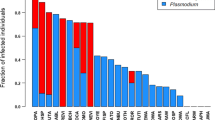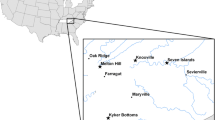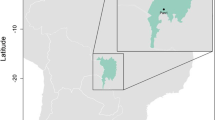Abstract
Parasite prevalence is thought to be positively related to host population density owing to enhanced contagion. However, the relationship between prevalence and local abundance of multiple host species is underexplored. We surveyed birds and their haemosporidian parasites (genera Plasmodium and Haemoproteus) at multiple sites across eastern North America to test whether the prevalence of these parasites in a host species at a particular site is related to that host’s local abundance. Prevalence was positively related to host abundance within most sites, although the effect was stronger and more consistent for Plasmodium than for Haemoproteus. In contrast, prevalence was not related to variation in the abundance of most individual host species among sites across the region. These results suggest that parasite prevalence partly reflects the relative abundances of host species in local assemblages. However, three nonnative host species had low prevalence despite being relatively abundant at one site, as predicted by the enemy release hypothesis.


Similar content being viewed by others
References
Arneberg P, Skorping A, Grenfell B, Read AF (1998) Host densities as determinants of abundance in parasite communities. Proc R Soc Lond B Biol Sci 265:1283–1289
Bates D, Maechler M, Bolker B, Walker S (2014) lme4: linear mixed-effects models using Eigen and S4 R package version 1.1-7
Bolker BM, Brooks ME, Clark CJ, Geange SW, Poulsen JR, Stevens MHH, White JSS (2009) Generalized linear mixed models: a practical guide for ecology and evolution. Trends Ecol Evol 24:127–135
Brown CR, Komar N, Quick SB, Sethi RA, Panella NA, Brown MB, Pfeffer M (2001) Arbovirus infection increases with group size. Proc R Soc Lond B Biol Sci 268:1833–1840
Browning SR, Browning BL (2011) Haplotype phasing: existing methods and new developments. Nat Rev Genet 12:703–714
Carlson JS, Walther E, TroutFryxell R, Staley S, Tell LA, Sehgal RNM, Barker CM, Cornel AJ (2015) Identifying avian malaria vectors: sampling methods influence outcomes. Parasit Vectors 8:1–16
Comita LS, Muller-Landau HC, Aguilar S, Hubbell SP (2010) Asymmetric density dependence shapes species abundances in a tropical tree community. Science 329:330–332
Crawley MJ (2007) The R book. Wiley, Ltd, West Sussex, England
Ellis VA, Collins MD, Medeiros MCI, Sari EHR, Coffey ED, Dickerson RC, Lugarini C, Stratford JA, Henry DR, Merrill L, Matthews AE, Hanson AA, Roberts JR, Joyce M, Kunkel MR, Ricklefs RE (2015) Local host specialization, host-switching, and dispersal shape the regional distributions of avian haemosporidian parasites. Proc Natl Acad Sci 112:11294–11299
Fallon SM, Ricklefs RE, Swanson BL, Bermingham E (2003) Detecting avian malaria: an improved polymerase chain reaction diagnostic. J Parasitol 89:1044–1047
Fallon SM, Bermingham E, Ricklefs RE (2005) Host specialization and geographic localization of avian malaria parasites: a regional analysis in the Lesser Antilles. Am Nat 165:466–480
Fecchio A, Lima MR, Svensson-Coelho M, Marini MA, Ricklefs RE (2013) Structure and organization of an avian haemosporidian assemblage in a Neotropical savanna in Brazil. Parasitology 140:181–192
González AD, Matta NE, Ellis VA, Miller ET, Ricklefs RE, Gutiérrez HR (2014) Mixed species flock, nest height, and elevation partially explain avian haemoparasite prevalence in Colombia. PLoS One 9:e100695
Hamer GL, Kitron UD, Goldberg TL, Brawn JD, Loss SR, Ruiz MO, Hayes DB, Walker ED (2009) Host selection by Culex pipiens mosquitoes and West Nile virus amplification. Am J Trop Med Hyg 80:268–278
Harrison XA (2015) A comparison of observation-level random effect and beta-binomial models for modelling overdispersion in binomial data in ecology and evolution. PeerJ 3:e1114
Hudson PJ, Dobson AP, Newborn D (1998) Prevention of population cycles by parasite removal. Science 282:2256–2258
Isaksson C, Sepil I, Baramidze V, Sheldon BC (2013) Explaining variance of avian malaria infection in the wild: the importance of host density, habitat, individual life-history and oxidative stress. BMC Ecol 13:15
Janzen DH (1970) Herbivores and the number of tree species in tropical forests. Am Nat 104:501–528
Keane RM, Crawley MJ (2002) Exotic plant invasions and the enemy release hypothesis. Trends Ecol Evol 17:164–170
Kilpatrick AM, Daszak P, Jones MJ, Marra PP, Kramer LD (2006) Host heterogeneity dominates West Nile virus transmission. Proc R Soc B Biol Sci 273:2327–2333
Kimura M, Dhondt AA, Lovette IJ (2006) Phylogeographic structuring of Plasmodium lineages across the North American range of the house finch (Carpodacus mexicanus). J Parasitol 92:1043–1049
Krasnov B, Khokhlova I, Shenbrot G (2002) The effect of host density on ectoparasite distribution: an example of a rodent parasitized by fleas. Ecology 83:164–175
LaDeau SL, Kilpatrick AM, Marra PP (2007) West Nile virus emergence and large-scale declines of North American bird populations. Nature 447:710–713
Lima M, Simpson L, Fecchio A, Kyaw C (2010) Low prevalence of haemosporidian parasites in the introduced house sparrow (Passer domesticus) in Brazil. Acta Parasitol 55:297
Longmire JL, Maltbie M, Baker RJ (1997) Use of “‘lysis buffer’” in DNA isolation and its implication for museum collections. Occas Pap Mus Tex Tech Univ 163:1–4
Lutz HL, Hochachka WM, Engel JI, Bell JA, Tkach VV, Bates JM, Hackett SJ, Weckstein JD (2015) Parasite prevalence corresponds to host life history in a diverse assemblage of afrotropical birds and haemosporidian parasites. PLoS One 10:e0121254
Mangan SA, Schnitzer SA, Herre EA, Mack KML, Valencia MC, Sanchez EI, Bever JD (2010) Negative plant–soil feedback predicts tree-species relative abundance in a tropical forest. Nature 466:752–755
Marzal A, Ricklefs RE, Valkiūnas G, Albayrak T, Arriero E, Bonneaud C, Czirják GA, Ewen J, Hellgren O, Hořáková D, Iezhova T, Jensen H, Križanauskienė A, Lima MR, de Lope F, Magnussen E, Martin LB, Møller AP, Palinauskas V, Pap PL, Pérez-Tris J, Sehgal RNM, Soler M, Szöllősi E, Westerdahl H, Zetindjiev P, Bensch S (2011) Diversity, loss, and gain of malaria parasites in a globally invasive bird. PLoS One 6:e21905
Matthews AE, Ellis VA, Hanson AA, Roberts JR, Ricklefs RE, Collins MD (2016) Avian haemosporidian prevalence and its relationship to host life histories in eastern Tennessee. J Ornithol 157:533–548
McGill BJ (2008) Exploring predictions of abundance from body mass using hierarchical comparative approaches. Am Nat 172:88–101
McGill BJ, Etienne RS, Gray JS, Alonso D, Anderson MJ, Benecha HK, Dornelas M, Enquist BJ, Green JL, He F, Hurlbert AH, Magurran AE, Marquet PA, Maurer BA, Ostling A, Soykan CU, Ugland KI, White EP (2007) Species abundance distributions: moving beyond single prediction theories to integration within an ecological framework. Ecol Lett 10:995–1015
Medeiros MCI, Hamer GL, Ricklefs RE (2013) Host compatibility rather than vector-host-encounter rate determines the host range of avian Plasmodium parasites. Proc R Soc B Biol Sci 280:20122947–20122947
Medeiros MCI, Ricklefs RE, Brawn JD, Hamer GL (2015) Plasmodium prevalence across avian host species is positively associated with exposure to mosquito vectors. Parasitology 142:1612–1620
Murray BR, Lepschi BJ (2004) Are locally rare species abundant elsewhere in their geographical range? Austral Ecol 29:287–293
O’Brien VA, Brown CR (2011) Group size and nest spacing affect Buggy Creek Virus (Togaviridae: Alphavirus) infection in nestling house sparrows. PLoS One 6:e25521
Packer A, Clay K (2000) Soil pathogens and spatial patterns of seedling mortality in a temperate tree. Nature 404:278–281
Packer A, Clay K (2003) Soil pathogens and Prunus serotina seedling and sapling growth near conspecific trees. Ecology 84:108–119
Parker IM, Saunders M, Bontrager M, Weitz AP, Hendricks R, Magarey R, Suiter K, Gilbert GS (2015) Phylogenetic structure and host abundance drive disease pressure in communities. Nature 520:542–544
R Core Team (2015) R: a language and environment for statistical computing
Ricklefs RE (1992) Embryonic development period and the prevalence of avian blood parasites. Proc Natl Acad Sci 89:4722–4725
Ricklefs RE (2011) Applying a regional community concept to forest birds of eastern North America. Proc Natl Acad Sci 108:2300–2305
Ricklefs RE (2012) Naturalists, natural history, and the nature of biological diversity. Am Nat 179:423–435
Ricklefs RE (2015) Intrinsic dynamics of the regional community. Ecol Lett 18:497–503
Ricklefs RE, Swanson BL, Fallon SM, Martínez-Abraín A, Scheuerlein A, Gray J, Latta SC (2005) Community relationships of avian malaria parasites in southern Missouri. Ecol Monogr 75:543–559
Ricklefs RE, Outlaw DC, Svensson-Coelho M, Medeiros MCI, Ellis VA, Latta S (2014) Species formation by host shifting in avian malaria parasites. Proc Natl Acad Sci 111:14816–14821
Ricklefs RE, Soares L, Ellis VA, Latta SC (2016) Haemosporidian parasites and avian host population abundance in the Lesser Antilles. J Biogeogr 43:1277–1286
Sauer JR, Peterjohn BG, Link WA (1994) Observer differences in the North American breeding bird survey. Auk 111:50–62
Stanko M, Krasnov BR, Morand S (2006) Relationship between host abundance and parasite distribution: inferring regulating mechanisms from census data. J Anim Ecol 75:575–583
Svensson LME, Ricklefs RE (2009) Low diversity and high intra-island variation in prevalence of avian Haemoproteus parasites on Barbados, Lesser Antilles. Parasitology 136:1121–1131
Svensson-Coelho M, Blake JG, Loiselle BA, Penrose AS, Parker PG, Ricklefs RE (2013) Diversity, prevalence, and host specificity of avian Plasmodium and Haemoproteus in a Western Amazon assemblage. Ornithol Monogr 76:1–47
Torchin ME, Lafferty KD, Dobson AP, McKenzie VJ, Kuris AM (2003) Introduced species and their missing parasites. Nature 421:628–630
Valkiūnas G (2005) Avian malaria parasites and other Haemosporidia. CRC Press, Boca Raton
Waldenström J, Bensch S, Hasselquist D, Östman Ö (2004) A new nested polymerase chain reaction method very efficient in detecting Plasmodium and Haemoproteus infections from avian blood. J Parasitol 90:191–194
Webb TJ, Gaston KJ (2003) On the heritability of geographic range sizes. Am Nat 161:553–566
Wickham H (2009) ggplot2: elegant graphics for data analysis. Springer, New York
Acknowledgments
Many people helped with collecting samples and permitting, for which we are grateful: B. Ryder, P. Marra, K. Tranquillo, P. Pyle, the Indiana MAPS teams, A. Burke, field biologist B. Keith and the Kalamazoo Valley Bird Observatory/Kalamazoo Nature Center, the Connecticut Audubon Society, S. Latta, W. Walstrom, D. Outlaw, E. Levenson, and K. Riley. P. Parker, I. Jiménez, S. Mangan, and an anonymous reviewer provided useful feedback on earlier versions of the manuscript. Our work would not have been possible without the help of numerous government and conservation agencies. We also thank the thousands of volunteers and organizers of the Breeding Bird Survey. Field and laboratory work was supported by the Harris World Ecology Center, the St. Louis Audubon Society, the Missouri Audubon Society, the Curators of the University of Missouri, the NSF Malaria Research Coordination Network, and a University of Missouri-St. Louis Dissertation Fellowship awarded to V.A.E.
Author information
Authors and Affiliations
Corresponding author
Ethics declarations
Ethical standards
All applicable federal, state, and institutional guidelines for the care and use of animals were followed in this study.
Conflict of interest
The authors declare that they have no conflict of interest.
Electronic supplementary material
Below is the link to the electronic supplementary material.
ESM 1
(DOCX 216 kb)
Rights and permissions
About this article
Cite this article
Ellis, V.A., Medeiros, M.C.I., Collins, M.D. et al. Prevalence of avian haemosporidian parasites is positively related to the abundance of host species at multiple sites within a region. Parasitol Res 116, 73–80 (2017). https://doi.org/10.1007/s00436-016-5263-3
Received:
Accepted:
Published:
Issue Date:
DOI: https://doi.org/10.1007/s00436-016-5263-3




